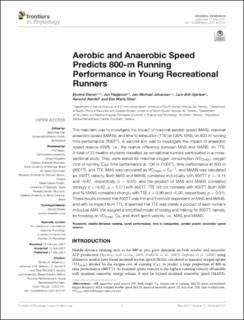| dc.description.abstract | The main aim was to investigate the impact of maximal aerobic speed (MAS), maximal anaerobic speed (MANS), and time to exhaustion (TTE) at 130% MAS, on 800-m running time performance (800TT). A second aim was to investigate the impact of anaerobic speed reserve (ASR), i.e., the relative difference between MAS and MANS, on TTE. A total of 22 healthy students classified as recreational runners participated in a cross-sectional study. They were tested for maximal oxygen consumption (VO2max), oxygen cost of running (CR), time performance at 100 m (100TT), time performance at 800 m (800TT), and TTE. MAS was calculated as VO2max × CR–1, and MANS was calculated as 100TT velocity. Both MAS and MANS correlated individually with 800TT (r = –0.74 and –0.67, respectively, p < 0.01), and the product of MAS and MANS correlated strongly (r = –0.82, p < 0.01) with 800TT. TTE did not correlate with 800TT. Both ASR and % MANS correlated strongly with TTE (r = 0.90 and –0.90, respectively, p < 0.01). These results showed that 800TT was first and foremost dependent on MAS and MANS, and with no impact from TTE. It seemed that TTE was merely a product of each runner’s individual ASR. We suggest a simplified model of testing and training for 800TT, namely, by focusing on VO2max, CR, and short sprint velocity, i.e., MAS and MANS. | en_US |

